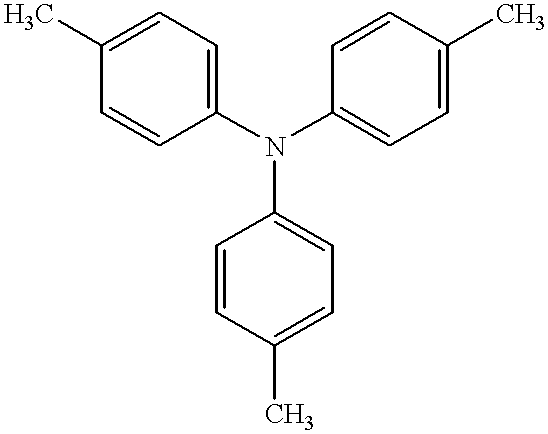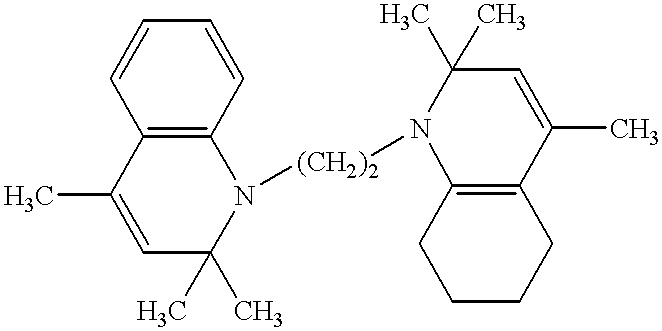Electrophotographic recording material containing metal-free phthalocyanines
a technology of phthalocyanine and electrophoresis, which is applied in the field of electrophoresis/magnetography, can solve the problems of difficult or impossible to remove impurities, incorporated tetrabenzoporphyrin pigments, and achieve the effect of high charge generation efficiency
- Summary
- Abstract
- Description
- Claims
- Application Information
AI Technical Summary
Benefits of technology
Problems solved by technology
Method used
Image
Examples
example 1
Preparation of a charge generating mixed crystal pigment in the X-crystal modification consisting of a 1:1 molar mixture of metal-free phthalocyanine and compound 1 of Table 1.
1) Preparation of 1,2,3-tricyanobenzene
A solution of 150 9 (1.08 moles) of 2,6-difluorobenzonitrile in 1500 ml of dry dimethylformamide was mixed with stirring and the exclusion of moisture at room temperature with 79.4 g (1.62 moles) of sodium cyanide. The reaction mixture was then vigorously stirred at room temperature for a further 24 hours.
The reaction mixture was then poured with stirring into 7.5 1 of ice-water, the resulting precipitate filtered off, the precipitate washed with water and the product dried to constant weight. The raw product (108.5 g) was then sublimed at a vacuum of 0.1 mbar and a bath temperature of 200.degree. C. A yield of 100.5 g of 1,2,3-tricyanobenzene, corresponding to 81.1% of the theoretical yield, was obtained with a melting point after recrystallization from toluene of 177-17...
example 2
Preparation of a charge generating mixed crystal pigment consisting of a 0.5:1 molar mixture of metal-free phthalocyanine and compound 2 of Table 1 in the X-crystal modification.
A) 3-chloro-1,2-dicyanobenzene can be prepared, for example from 2-chloro, 6-fluorobenzonitrile using an analogous synthesis procedure to that described in Example 1(A).
B) Preparation of mixed crystal pigment consisting of a 0.5:1 molar mixture of metal-free phthalocyanine and compound 2 of Table 1 in the .alpha.-crystal modification.
2.7 g of 3-chloro-1,2-dicyanobenzene and 10.7 g of phthalonitrile were dissolved in 150 ml of amylalcohol. 15 ml of a 30% sodium methylate solution in methanol were then added and the reaction mixture heated under reflux for 6 hours. The disodium salt formed was filtered off from the cooled reaction mixture suspended in 100 ml of water and was then treated with 100 ml of 10% hydrochloric acid for 30 minutes with stirring at room temperature. The resulting mixed crystal pigment c...
example 3
A photoconductor sheet was produced by coating a 175 .mu.m thick polyester film vapour-coated with a conductive layer of aluminium successively with a hydrolyzed silane adhesive layer, a dispersion of charge generating pigment to a thickness of 0.6 .mu.m and a filtered solution of charge transport substance and binder to a thickness of 11.4 .mu.m. The coating proceeded in each case with a doctor-blade coater.
The hydrolyzed silane adhesive layer was prepared by coating a 3% by weight solution of .gamma.-aminopropyl triethoxy silane on the aluminized polyester substrate an d hydrolyzing / polymerizing it at 100.degree. C. for 30 minutes.
The charge generating pigment dispersion was prepared by mixing 1 g of the X-modification of a mixed crystal pigment consisting of a 1:1 molar mixture of metal-free phthalocyanine and compound 1 of Table 1 prepared as described in example 1, 0.15 g of MAKROLON CD 2000 (tradename) and 10.34 g of dichloromethane for 40 hours in a ball mill. 0.85 g of MAKRO...
PUM
| Property | Measurement | Unit |
|---|---|---|
| thickness | aaaaa | aaaaa |
| thickness | aaaaa | aaaaa |
| wavelength range | aaaaa | aaaaa |
Abstract
Description
Claims
Application Information
 Login to View More
Login to View More - R&D
- Intellectual Property
- Life Sciences
- Materials
- Tech Scout
- Unparalleled Data Quality
- Higher Quality Content
- 60% Fewer Hallucinations
Browse by: Latest US Patents, China's latest patents, Technical Efficacy Thesaurus, Application Domain, Technology Topic, Popular Technical Reports.
© 2025 PatSnap. All rights reserved.Legal|Privacy policy|Modern Slavery Act Transparency Statement|Sitemap|About US| Contact US: help@patsnap.com



